Notable aliases Prince of Chichester | Alter ego Groo Abilities Master swordsman | |
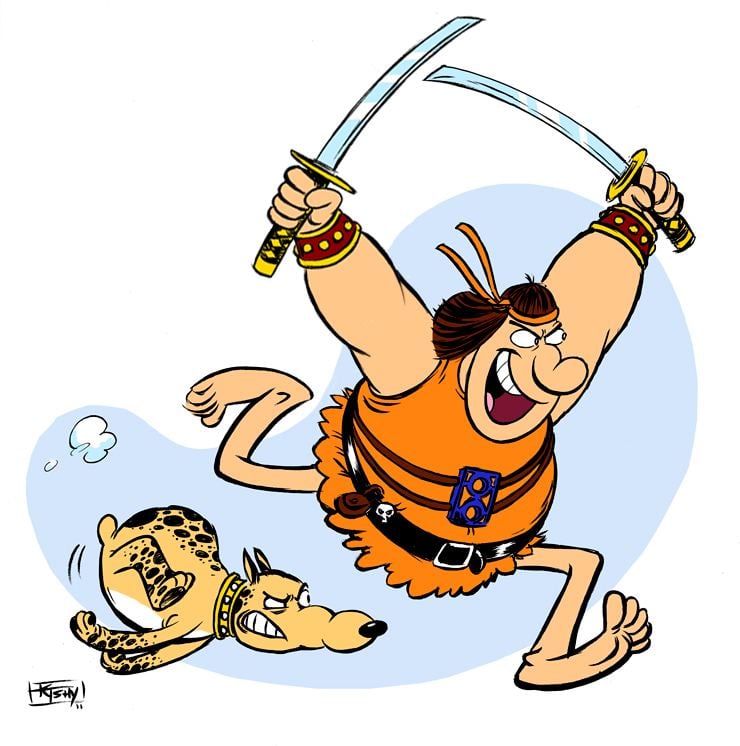 | ||
Publisher Pacific ComicsEclipse ComicsEpic/Marvel ComicsImage ComicsDark Horse Comics Similar Conan the Barbarian, Destroyer Duck, Savage Dragon, Foolkiller, Lobster Johnson | ||
Groo the wanderer animated teaser cartoon network new show
Groo the Wanderer is a fantasy/comedy comic book series written and drawn by Sergio Aragonés, rewritten, co-plotted and edited by Mark Evanier, lettered by Stan Sakai and colored by Tom Luth. Over the years it has been published by Pacific Comics, Eclipse Comics (one special issue), Marvel Comics (under its Epic imprint), Image Comics and Dark Horse Comics.
Contents
- Groo the wanderer animated teaser cartoon network new show
- Sergio aragones draws and discusses groo the wanderer
- The characters
- The setting
- The creators
- Publication history
- Similar characters
- List of Stories
- Awards and nominations
- References
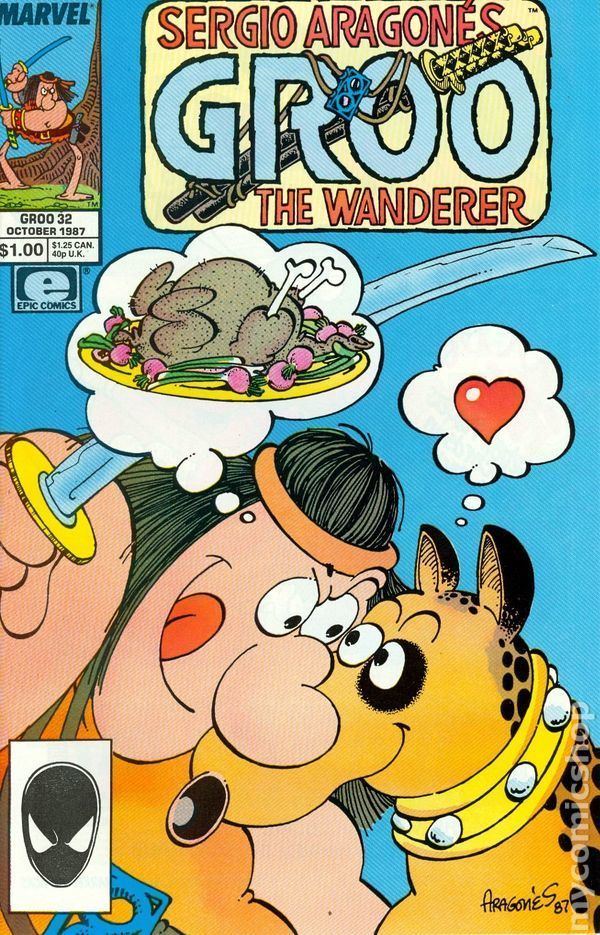
Groo was one of the first widely successful creator-owned comics, one of the few successful humorous comic books in the United States (outside Archie Comics) during its time, and one of the longest-running collaborations in comic book history. In 2011 IGN ranked Groo 100th in the "Top 100 comic books heroes".
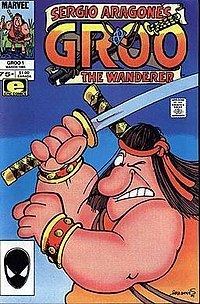
Sergio aragones draws and discusses groo the wanderer
The characters
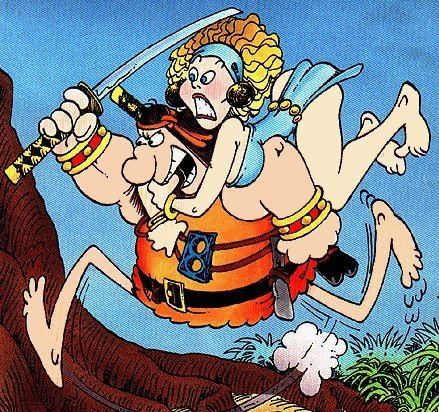
Groo (the epithet "the Wanderer" is informal and rarely mentioned within the stories) first appeared as a parody of the brutal sword and sorcery heroes who were popular at the time of his creation in the 1970s, especially Conan the Barbarian as presented in Marvel Comics. Groo is a large-nosed buffoon of unsurpassed stupidity who constantly misunderstands his surroundings. Possessed of superlative skills in swordsmanship (the only task at which he is remotely competent) he delights in combat but otherwise is a peaceable and honest fellow who tries to make his way through life as a mercenary or by working odd jobs. He is incredibly accident-prone, and despite generally good intentions causes mass destruction wherever he goes. Most of his adventures end with him either oblivious to the mayhem he has wrought or fleeing an angry mob. His penchant for destruction has become so widely known that just the news of Groo approaching is sometimes enough to cause chaos among the population. Groo occasionally meets with respect and good fortune, but it does not last. Businesses, towns, civilizations and cultures have all been unwittingly destroyed by Groo. Such is Groo's incompetence that so much as stepping onto a ship can cause it to sink.
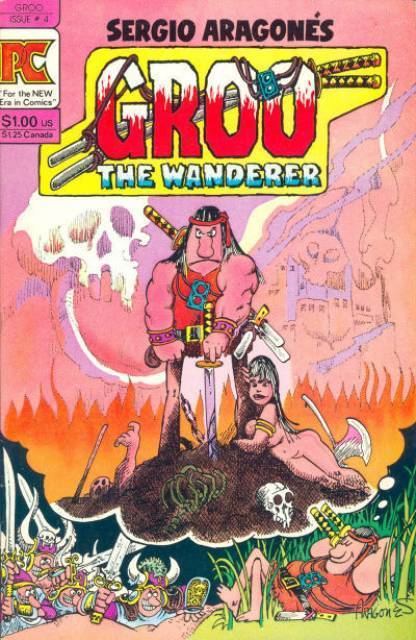
Groo has slain entire armies with nothing more than his swords, which appear to be a pair of katanas. Groo loves these frays, as he calls them, and often charges into the melee with a cry of "Now Groo does what Groo does best!" He is indiscriminate in the use of his battle skills, usually leaping into battle before attempting to ascertain the reasons for the fight, or even who is on what side. Even when Groo does join battle intending to fight for a particular side, he is prone to forget which side he is on, or be tricked into fighting his unfortunate allies.
In his travels, Groo has encountered thousands of characters. However, there is an assortment of recurring characters:
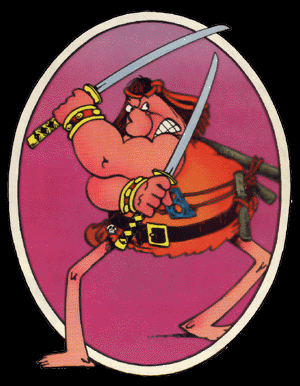
The setting
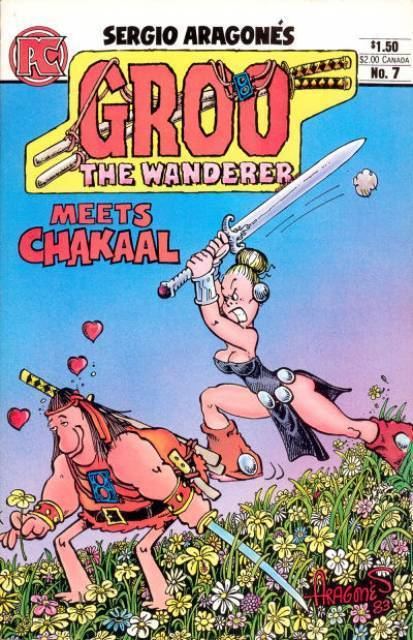
Groo's adventures take place in an environment that generally resembles Medieval Europe, although his travels have also taken him to places that resemble Africa, Indonesia, Japan, the Middle East, and elsewhere. In addition to regular flora and fauna, dragons and other legendary creatures occasionally appear, and several cultures use dinosaur-like creatures as beasts of burden. Over the years, Groo has also encountered several "non-human" cultures such as the Kalelis and the Drazil. The currency in Groo's world is usually the Kopin.
Although many technologies and peoples in Groo appear ancient, more modern innovations such as the printing press can be found as well.
The creators
Groo is initially plotted and drawn by Sergio Aragonés, and Mark Evanier then writes the dialog. Sakai then does the lettering, after which Aragonés does the final artwork, including the word balloons. Finally, Luth does the coloring.
Evanier also answers the letters page, something he takes special pride in, since the practice in mainstream comics is to pass this task off to low-level assistants, something he did not know when his own teenage fan letters were published. He claims that no one knows what he does, and that he does not get paid. His official credit, during the Marvel/Epic run, was usually a ludicrously polysyllabic title that changed every issue.
Caricatures of Aragonés, Evanier, Sakai, and Luth often appear as background characters within the stories, sometimes with family members. Evanier and Sakai are also the role models for the characters Weaver and Scribe.
Rufferto was based on Aragonés' own dog named Rufferto, who is actually more mottled than spotted.
Publication history
Aragonés created the character of Groo in the late 1970s. However, at that time no comic-book company would allow creators to retain the rights to their characters, and Aragonés did not wish to surrender those rights. In 1981, a comic book, Destroyer Duck #1, was published by Eclipse Comics as a benefit to raise money for a legal battle over creator rights; a four-page story contributed by Aragonés featured Groo's first published appearance. A few months later, Groo appeared in a two-page preview ad and the back cover art in Starslayer #4, published by Pacific Comics. The second Groo story appearance was in a five-page back-up story in Starslayer #5.
In 1982, Pacific Comics began publishing Groo The Wanderer as a regular series. Pacific faced various financial difficulties and was only able to publish eight issues of the title. With Pacific unable to publish new material, a one-shot issue of material that was originally written for them (titled the Groo Special) was instead published by Eclipse. When Groo was published by Pacific, he was not portrayed as a bumbling idiot. In fact, one issue had him use his brains to create sophisticated traps and his speech was similar to Conan the Barbarian's.
Aragonés and Evanier eventually negotiated a deal with Epic Comics, an imprint of Marvel Comics, for that company to take care of publication while preserving creator rights. This resulted in the longest run of Groo the Wanderer with 120 issues. In 1994, with Marvel facing financial difficulties, the title switched to Image Comics and was retitled Groo. (In the first issue Groo remarks "The marvels of the world are but images before me.")
When Image in turn faced legal problems after publishing twelve issues, the title switched to Dark Horse Comics in 1998. Dark Horse is not publishing the title as a regular series, but is periodically releasing new material and reprints as mini-series and collections.
At the 2007 WonderCon, the creators revealed that since 2005 they had been trying to produce a Groo/Conan crossover (both titles are published by Dark Horse). The project encountered a number of postponements; although two issues had been completed by the spring of 2011, the series was further delayed because of a backache suffered by Aragonés. The book finally saw print in July 2014, with Aragonés and writer Mark Evanier working with artist Thomas Yeates, who drew the Conan portions of the book.
Similar characters
The character of The Groosalugg in the TV series Angel is generally called 'Groo' by other characters, and is a somewhat naive wandering barbarian hero who is a highly skilled swordsman.
In Norway, the magazine Pyton once parodied the comic by placing the Norwegian Prime Minister Gro Harlem Brundtland in the role of Groo. The parody was a pun on her name (adding one letter-an 'o').
Also in Norway, when the local version of MAD ran a parody of Ronia the Robber's Daughter, the "gray dwarves" pestering Ronia had become "Groo dwarves".
List of Stories
List of Groo the Wanderer stories
Awards and nominations
Sergio Aragones received the National Cartoonist Society Reuben Award for 1996 for his work on Groo and Mad Magazine. In 2009, Groo: Hell on Earth was nominated for the Eisner Award for Best Limited Series.
The comic protagonist of the same name has also received positive reviews. Wizard magazine ranked him as the 135th greatest comic book character of all time while IGN ranked Groo as the 100th greatest comic book hero of all time stating that "...while he may not be the brightest bulb on the battlefield, Groo is an earnest and kind-hearted adventurer whose travels are never short on laughs and adventure."
